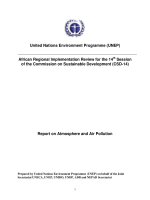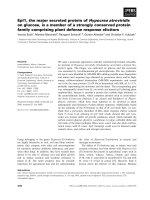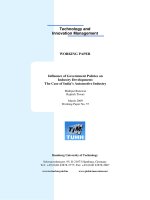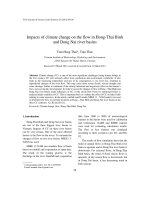the impacts of the handoffs on software development a cost estimation model
Bạn đang xem bản rút gọn của tài liệu. Xem và tải ngay bản đầy đủ của tài liệu tại đây (1.41 MB, 201 trang )
The Impacts of the Handoffs on Software Development: A Cost Estimation Model
by
Michael Jay Douglas
A dissertation submitted in partial fulfillment
of the requirements for the degree of
Doctor of Philosophy
Department of Information Systems and Decision Sciences
College of Business Administration
University of South Florida
Co-Major Professor: Alan R. Hevner, Ph.D.
Co-Major Professor: Rosann Webb Collins, Ph.D.
Anol Bhattacherjee, Ph.D.
Kaushal Chari, Ph.D.
Date of Approval:
May 8, 2006
Keywords: cocomo ii, psestimate, experiment, design science
© Copyright 2006 , Michael Jay Douglas
UMI Number: 3230373
3230373
2006
Copyright 2006 by
Douglas, Michael Jay
UMI Microform
Copyright
All rights reserved. This microform edition is protected against
unauthorized copying under Title 17, United States Code.
ProQuest Information and Learning Company
300 North Zeeb Road
P.O. Box 1346
Ann Arbor, MI 48106-1346
All rights reserved.
by ProQuest Information and Learning Company.
i
TABLE OF CONTENTS
LIST OF EQUATIONS VI
LIST OF TABLES VII
LIST OF FIGURES IX
ABSTRACT X
CHAPTER 1 INTRODUCTION 1
1.1 INTRODUCTION 1
1.2 SOFTWARE COST ESTIMATION DIFFICULTIES 3
1.3 SOFTWARE COST ESTIMATION MODELS HELP 5
1.4 ATTRIBUTES OF A GOOD MODEL 6
1.5 THE SOFTWARE HANDOFF 9
1.6 THE SOFTWARE HANDOFF AND TEAM SIZE 11
1.7 SOFTWARE HANDOFF AND PROCESS STRUCTURE 12
1.8 INTER-GROUP COORDINATION 15
1.9 RESEARCH QUESTIONS 16
1.10 NEW SOFTWARE COST ESTIMATION MODEL 17
1.11 RESEARCH PARADIGM 18
1.12 CONTRIBUTIONS 21
1.13 DISSERTATION FORMAT 21
CHAPTER 2 LITERATURE REVIEW 23
2.1 INTRODUCTION 23
2.2 COST ESTIMATION NEEDS 26
2.3 COST ESTIMATION SOLUTIONS 28
2.4 EMPIRICAL MODEL BUILDING 39
2.5 COCOMO 40
ii
2.6 COCOMO II 42
2.7 OTHER MODERN SOFTWARE COST ESTIMATION TOOLS 43
2.8 NEW FINDINGS NOT ASSIMILATED INTO SOFTWARE COST ESTIMATION MODELS 43
2.9 EMPIRICAL DATASETS 47
2.10 OTHER VALIDATION APPROACHES 47
2.11 CONCLUSIONS 48
CHAPTER 3 COST ESTIMATION IN COCOMO II 49
3.1 INTRODUCTION 49
3.2 PROJECT CHARACTERISTICS 49
3.3 COCOMO II OUTPUTS 57
3.4 MODEL TYPES 61
3.5 EFFORT ESTIMATION 62
3.6 SCHEDULE 63
3.7 STAFFING 64
3.8 COCOMO II OVERVIEW 64
CHAPTER 4 COMMUNICATION OVERHEAD 65
4.1 INTRODUCTION 65
4.2 COMMUNICATION OVERHEAD DEFINITION 65
4.3 QUANTIFYING COMMUNICATION OVERHEAD 67
4.4 COOPERATING PROGRAM MODEL - COPMO 69
4.5 COMMUNICATION OVERHEAD CONTRIBUTIONS 70
CHAPTER 5 EXTENDED ESTIMATION MODEL 71
5.1 INTRODUCTION 71
5.2 MODEL OVERVIEW 72
5.3 EXTENDED EXAMPLE INFORMATION 74
iii
5.4 USING THE COCOMO II OUTPUTS 75
5.5 MODELING THE WORK BREAKDOWN STRUCTURE IN PROCESS STRUCTURES 79
5.6 MAPPING OF THE THREE-TIER PROCESS STRUCTURE 82
5.7 MAPPING OF THE TWO-TIER PROCESS STRUCTURE 85
5.8 MAPPING OF THE ONE-TIER PROCESS STRUCTURE 86
5.9 POPULATING STAFFING INTO THE PROCESS STRUCTURES 87
5.10 EFFORT CALCULATION 91
5.11 THREE-TIER STRUCTURE 91
5.12 TWO-TIER STRUCTURE 99
5.13 ONE-TIER STRUCTURE 104
5.14 STAFF LOADING 105
5.15 OPTIMIZATION 105
5.16 CONCLUSION 107
CHAPTER 6 DECISION SUPPORT TOOL 108
6.1 EXAMPLE TEST RUN 108
6.2 TOOL DISCUSSION 110
6.3 TOOL CONSTRUCTION 113
CHAPTER 7 EXPERIMENTAL VALIDATION 115
7.1 INTRODUCTION 115
7.2 STUDY RATIONALE 116
7.3 INSTITUTIONAL REVIEW 118
7.4 RESEARCH QUESTION 118
7.5 HYPOTHESES 119
7.6 PRETEST 120
7.7 PILOT TEST 121
7.8 MAIN STUDY 121
iv
7.9 TRAINING 122
7.10 EXPERIMENTAL TASKS 122
7.11 EXPERIMENTAL TASK 1 123
7.12 EXPERIMENTAL TASK 2 124
7.13 POST EXPERIMENT QUESTIONNAIRE 126
CHAPTER 8 RESULTS AND DISCUSSION 128
8.1 INTRODUCTION 128
8.2 TREATMENT BREAKDOWN 129
8.3 DATA ANALYSIS OVERVIEW 129
8.4 EXPERT VALIDATION 130
8.5 ACCURACY 130
8.6 CONSISTENCY 136
8.7 CONFIDENCE 137
8.8 SATISFACTION AND PERCEIVED USEFULNESS 139
CHAPTER 9 CONCLUSIONS AND CONTRIBUTIONS 144
9.1 INTRODUCTION 144
9.2 CONTRIBUTIONS TO RESEARCH 144
9.3 CONTRIBUTIONS TO PRACTICE 146
9.4 LIMITATIONS AND KEY ASSUMPTIONS 148
9.5 FUTURE WORK 149
APPENDICES 158
APPENDIX A: KEMERER DATASET 159
APPENDIX B: MERMAID-2 DATASET 160
APPENDIX C: LINGO SCRIPT FOR TIER-THREE 161
APPENDIX D: INSTITUTIONAL REVIEW BOARD APPROVAL 163
v
APPENDIX E: EXPERIMENTAL MATERIALS 164
ABOUT THE AUTHOR END PAGE
vi
LIST OF EQUATIONS
EQUATION 2.1 EFFORT EQUATION 32
EQUATION 2.2 SIZE EQUATION 32
EQUATION 2.3 BASIC EFFORT EQUATION 39
EQUATION 2.4 BASIC COCOMO EQUATION 40
EQUATION 2.5 COCOMO EFFORT EQUATION 41
EQUATION 2.6 INTERMEDIATE COCOMO EFFORT EQUATION 42
EQUATION 3.1 ECONOMY OF SCALE EQUATION 54
EQUATION 3.2 NOMINAL EFFORT 63
EQUATION 3.3 SCHEDULE ESTIMATION 63
EQUATION 3.4 STAFFING EQUATION 64
EQUATION 4.1 COMMUNICATION PATHS FOR N PEOPLE 66
EQUATION 4.2 PREDICTION EQUATION FOR COMMUNICATION OVERHEAD 68
EQUATION 4.3 COPMO EQUATION 69
EQUATION 5.1 COMMUNICATION PATHS FOR N PEOPLE 92
EQUATION 5.2 PREDICTION EQUATION FOR COMMUNICATION OVERHEAD 92
EQUATION 5.3 EFFORT MULTIPLIERS DUE TO INTRA-GROUP COMMUNICATION 94
EQUATION 5.4 TIER-THREE EFFORT MAPPING EQUATIONS 95
vii
LIST OF TABLES
TABLE 2-1 BASIC COCOMO CONSTANTS 41
TABLE 3-1 UNADJUSTED FP TO SLOC CONVERSION RATIOS 52
TABLE 3-2 SCALE FACTORS 54
TABLE 3-3 POST-ARCHITECTURE EFFORT MULTIPLIERS 56
TABLE 3-4 EARLY DESIGN EFFORT MULTIPLIERS 57
TABLE 3-5 PLANS AND REQUIREMENTS ACTIVITY DISTRIBUTION 59
TABLE 3-6 PRODUCT DESIGN ACTIVITY DISTRIBUTION 59
TABLE 3-7 PROGRAMMING ACTIVITY DISTRIBUTION 60
TABLE 3-8 INTEGRATION AND TEST ACTIVITY DISTRIBUTION 60
TABLE 3-9 WORK BREAKDOWN STRUCTURE FOR A MEDIUM SIZE PROJECT 60
TABLE 3-10 SOFTWARE COST ESTIMATION MODEL TYPES 62
TABLE 4-1 COMMUNICATION OVERHEAD PERCENTAGE AS A GIVEN TEAM SIZE 68
TABLE 4-2 COMMUNICATION PATHS ADDED TO COMMUNICATION OVERHEAD 68
TABLE 4-3 COPMO AND COMMUNICATION OVERHEAD 69
TABLE 5-1 PLANS AND REQUIREMENTS ACTIVITY DISTRIBUTION 76
TABLE 5-2 PRODUCT DESIGN ACTIVITY DISTRIBUTION 76
TABLE 5-3 PROGRAMMING ACTIVITY DISTRIBUTION 77
TABLE 5-4 INTEGRATION AND TEST ACTIVITY DISTRIBUTION 77
TABLE 5-5 PLANS AND REQUIREMENTS PHASE FOR A 40 KSLOC PROJECT 78
TABLE 5-6 COMPLETE WORK BREAKDOWN STRUCTURE FOR EXTENDED EXAMPLE 78
TABLE 5-7 WORK BREAKDOWN STRUCTURE MAPPING 79
TABLE 5-8 ADJUSTED WORK BREAKDOWN STRUCTURE 81
TABLE 5-9 EXAMPLE TEAM SIZES 91
TABLE 7-1 RANDOMIZING TO TREATMENTS 117
TABLE 7-2 RESEARCH MODEL 119
TABLE 7-3 EXPERIMENTAL TASKS OVERVIEW 126
viii
TABLE 8-1 TREATMENT BREAKDOWN 129
TABLE 8-2 EXPERTS RATINGS OF EFFORT AND SCHEDULE FOR TASKS 130
TABLE 8-3 RESULTS FOR TASK 1 FOR EFFORT 131
TABLE 8-4 RESULTS FOR TASK 2 FOR EFFORT 131
TABLE 8-5 BOOTSTRAP P-VALS FOR EFFORT 132
TABLE 8-6 RESULTS FOR TASK 1 FOR SCHEDULE 132
TABLE 8-7 RESULTS FOR TASK 2 FOR SCHEDULE 132
TABLE 8-8 BOOTSTRAP P-VALS FOR SCHEDULE 133
TABLE 8-9 WELCH'S ANOVA FOR EFFORT AND SCHEDULE 133
TABLE 8-10 BOOTSTRAP P-VALS FOR EFFORT 134
TABLE 8-11 BOOTSTRAP P-VALS FOR SCHEDULE 134
TABLE 8-12 ACCURACY RESULTS VS. EXPERT 135
TABLE 8-13 LEVENE TEST FOR EFFORT AND SCHEDULE 136
TABLE 8-14 PIVOT TABLE OF CONFIDENCE TYPE RESULTS 139
TABLE 8-15 RESULTS OF TOOL VS. NO TOOL FOR CONFIDENCE 139
TABLE 8-16 ITEM-TOTAL FOR SATISFACTION 141
TABLE 8-17 ITEM-TOTAL AND CRONBACH’S ALPHA FOR PERCEIVED USEFULNESS 141
TABLE 8-18 SATISFACTION AND TREATMENT MEANS 142
TABLE 8-19 BOOTSTRAP P-VALS FOR SATISFACTION AND PERCEIVED USEFULNESS 142
TABLE 9-1 COCOMO II SCHEDULE REDUCTION MULTIPLIER 147
ix
LIST OF FIGURES
FIGURE 1-1 TYPICAL PROJECT RESOLUTIONS 2
FIGURE 1-2 THREE-TIER MODEL 13
FIGURE 1-3 TWO-TIER MODEL 14
FIGURE 1-4 ONE-TIER MODEL 14
FIGURE 1-5 RESEARCH MODEL 17
FIGURE 1-6 NEW SOFTWARE COST ESTIMATION MODEL 18
FIGURE 1-7 DESIGN SCIENCE RESEARCH MODEL 20
FIGURE 5-1 MODEL OVERVIEW 74
FIGURE 5-2 EFFORT BREAKDOWN FOR THREE-TIER 83
FIGURE 5-3 TWO-TIER EFFORT BREAKDOWN 86
FIGURE 5-4 ONE-TIER PROCESS STRUCTURE 87
FIGURE 5-5 THREE-TIER MODEL 88
FIGURE 5-6 TWO-TIER MODEL 89
FIGURE 5-7 ONE-TIER MODEL 90
FIGURE 5-8 EFFORT BREAKDOWN FOR THREE-TIER 93
FIGURE 5-9 TWO-TIER EFFORT BREAKDOWN 100
FIGURE 6-1 SCREENSHOT OF ESTIMATING SOFTWARE SIZE 111
FIGURE 6-2: SCREENSHOT OF DEVELOPED TOOL - SIMULATION RESULTS 112
FIGURE 6-3: SCREENSHOT OF DEVELOPED TOOL - AFTER OPTIMIZATION 113
FIGURE 7-1 DESIGN SCIENCE RESEARCH MODEL 115
FIGURE 8-1 EMPIRICAL RESEARCH MODEL 128
x
The Impacts of the Handoffs on Software Development:
A Cost Estimation Model
Michael Jay Douglas
ABSTRACT
Effective software cost estimation is one of the most challenging and important
activities in software development. The software industry does not estimate projects
well. Poor estimation leads to poor project planning with resulting schedule overruns,
inadequate staffing, low system quality, and many aborted projects. Research on
software estimation is needed to build more accurate models of the key aspects of
software development. The goals of research in this dissertation are to investigate and
improve the modeling of team size and project structures in current software estimation
methods.
Mathematical models for estimating the impacts of project team size and three
variations of project structure are developed. These models accept the outputs of the
COCOMO II software estimation tool, allow variation in both team size and project
structure, and produce more detailed project estimates. This new extended model of
COCOMO II is implemented in a decision support tool for software estimators called
PSEstimate.
xi
Following the design science research paradigm, the artifact is evaluated with an
experiment with experienced software project managers. Three treatment groups: a
manual (no tool) group, a COCOMO II group, and a PSEstimate group, completed two
multipart software cost estimation tasks. The accuracy and consistency of the cost and
schedule estimates, the participants’ confidence in their estimates, and their satisfaction
with and perceived usefulness of the cost estimation tool are measured.
The experimental results support most of the hypotheses of the dissertation. For
most tasks, individuals aided by computer-based decision support tools produce more
accurate project effort estimates and are more confident in their estimates than manual
estimators. There are no significant differences between the three groups on schedule
estimation. A possible explanation is that experienced estimators in the manual group
compensate for the inaccuracy of their effort estimates by adding time to their schedule
estimates.
The research contributions are new mathematical models for software estimation
based on project team size and structure; a decision support tool (PSEstimate) that
incorporates these models; and the experimental results that demonstrate improvements
in software estimation by experienced project managers when the new models and tool
are applied in practice.
1
CHAPTER 1 INTRODUCTION
When you can measure what you are speaking about, and express it in
numbers, you know something about it; but when you cannot measure it,
when you cannot express it in numbers, your knowledge is of a meager
and unsatisfactory kind; it may be the beginning of knowledge, but you
have scarcely in your thoughts advanced to the stage of science.
- William Thomson (Lord Kelvin), 1891
1.1 Introduction
Software cost estimation remains an important unsolved practical problem in
software engineering (Lewis 2001). Software cost estimation has failed, in most cases, to
accurately predict the actual costs or the time needed to develop the system (Vijayakumar
1997). Project managers have the responsibility to make accurate estimations of cost and
effort, but without good software cost estimation tools, the effectiveness of software
project management is reduced (Agarwal, Kumar et al. 2001). A good software cost
estimation model can significantly help software project managers make informed
decisions on how to manage resources, control and plan a project, and deliver a project
on time, on schedule, and on budget (Chen, Menzies et al. 2005). The problems in
estimation are exacerbated by continued changes in software technologies. Thus,
software cost estimation models require constant modification to stay current (Jones
2002). Further research in software cost estimation is clearly needed.
In the United States, more than 250 billion dollars is spent each year on IT
application development (The Standish Group 2003), but in 1994, only 16.2% of
2
software development projects were completed both on-time and on-budget (Standish
Group Inc. 1994). Almost ten years later, only 32% of projects are successful (The
Standish Group 2003). Some companies can expect that a typical software development
project will be delivered a year late at double the budget (Paulk 1995). Figure 1-1
illustrates typical project resolutions, and highlights how late many projects are delivered.
22% of the projects in this data set took more than twice as long to complete than was
originally expected.
Cancelled
29%
On-Time
26%
21%-50% Late
8%
51%-100% Late
9%
101%-200 Late
16%
More than 200% Late
6%
Less than 20% Late
6%
Figure 1-1 Typical Project Resolutions
(McConnell 2000)
Poor project planning and management results in companies taking a collective
loss of $80 billion annually on new software projects that eventually get cancelled (King
1997). Cancelled projects are especially problematic given that projects are commonly
cancelled in the later stages of development after significant resources have been
3
expended on behalf on the project. The average cancelled project in the United States is
about a year behind schedule and has consumed 200 percent of its expected budgeted by
the time it has been cancelled (Jones 1993).
A goal of project managers is to guide to completion a software development
project. A successful software development project will deliver to the users a system
desired by the customers. If the people that financially support the software development
and the users of the software are satisfied, the system can be considered successful. Part
of the desired system could be parameters such as: total system development cost,
scheduled delivery date, functionality, and quality. The project manager needs to
supervise the software development project so that the desired system is delivered.
Reasonable estimates of cost, schedule, and staff are critical guides that help the project
manager successfully control the software development activities
1.2 Software Cost Estimation Difficulties
Estimating software development costs with accuracy is very difficult. The most
common approach for improving software cost estimates is to use empirical models
(Mukhopadhyay, Vicinanza et al. 1992). The predictive accuracy of software cost
estimation models is not satisfactory, since model-based estimates are generally within
25% of the actual cost or schedule, one-half of the time (Ferens and Christensen 2000).
This means that more than one-half of estimates are off by more than 25 percent, when
comparing the actual versus estimated metric. When poor results are found using
software cost estimation models, many researchers suggest calibrating the parameters of a
model to a specific environment (Kemerer 1987; van Genuchten and Koolen 1991;
4
Andolfi 1996). However, results from calibrating software cost estimation models show
that the predictive accuracy does not always improve (Ferens and Christensen 1998).
The additional goal of being able to predict the costs and schedule at the
beginning of the project can prove to be more challenging. “Early prediction of
completion time is absolutely essential for proper advance planning and aversion of the
possible ruin of a project” (Pillai and Nair 1997 p.485). Nevertheless, using the entire
suite of available software cost estimation models, researchers find that there is no
evidence that software models are effective at estimating projects at an early stage of
system development (Vijayakumar 2002). Yet, estimation does not stop because it is
inaccurate. Instead of using a model, software cost estimation continues to be most
commonly conducted by experts, sometimes using a Bayesian approach to manage the
uncertainty (Stamelos, Angelis et al. 2003).
McConnell suggests there is a lack of understanding as to what developing
software means. The difficulty in creating good software cost estimation models is
directly related to the lack of understanding about software development.
The problems in developing today’s and tomorrow’s systems are
overwhelming; they require many different types of problems to be
solved. No other scientific or engineering discipline relies on a single
technique for addressing problems, so why are we, so-called professional
engineers (and computer scientists), stupid enough to think that our field is
fundamentally different in this respect? So, what do we need to do? First,
industrial management has to understand that software engineering is not
an engineering discipline like so many others (yet) and that standards,
methods, and tools are all likely to be wrong (once we really understand
what developing software means) (McConnell 2000 p.17).
5
The current software cost estimation tools have not yet reached a level of
accuracy required for proper advanced planning. Research is needed to improve the
understanding of software development and then use that knowledge gained to create
better software cost estimation models.
1.3 Software Cost Estimation Models Help
A software cost estimation model provides a formal method for estimating
software costs and schedule. Because of the lack of predictive validity, some project
managers believe that using formal methods to estimate software costs is a wasted effort
and instead use intuitive judgment (Paulk 1995) or external sources, such as senior
project managers desires for cost estimates (Agarwal, Kumar et al. 2001). Senior
management needs are not usually based on the capabilities of the development staff.
These needs are therefore subject to schedule and budget overruns.
Even with the predictive problems of software cost estimation models, the models
prove to be better than any alternative method of estimation. For example, simple
statistical models have been shown to be superior to using human judgment even though
the statistical models were created by the humans (Paulk 1995). Consistent answers when
given the same input are one reason there is an advantage of using models over humans.
An incomplete model is better than no model at all; therefore, research is conducted to
improve models rather than using other methods of estimation, such as expert opinion.
6
1.4 Attributes of a Good Model
There are three requirements for a software cost estimation model that will make
accurate predictions of software effort and schedule. The first requirement is that the
estimation model is built on a solid foundation of prior research and empirically tested.
Software cost estimation models have two problems. First, “The domain of software
effort estimation lacks a strong causal model based on deep principles and is situated
within an often-changing, highly context-dependent task environment” (Mukhopadhyay,
Vicinanza et al. 1992 p.156). Second, attempts at validating software cost estimation
models have been largely unsuccessful (Mukhopadhyay, Vicinanza et al. 1992).
Since there is a lack of theoretical support describing the complicated process of
how software development impacts software development costs, using historical data as a
basis for software cost estimation is very insightful. Having an organization collect data
during software development is the first step in trying to improve estimates. Boeing
Information Systems used historical data and drastically increased the quality of software
estimates. Without historical data, the variance in effort ranged from -145% to +20%,
whereas with historical data the variance was reduced to -20% to +20% (Vu 1997).
Boeing Information Systems still encountered cost overruns, but moving from 145% to
only 20% was a big improvement. By measuring and documenting the software
development process, future estimates are based on empirical data rather than pure
speculation.
The second requirement of a good estimation model is that the development
process follows a repeatable process. A software development organization that follows a
7
repeatable process is more mature because a higher amount of discipline is instilled into
software development activities. The maturity of an organizations software process
influences its ability to meet costs, quality, and schedule target (Curtis 1992). In 1994,
75% of all software organizations did not use a disciplined approach to development
software. “The immature software organization is reactionary and managers are usually
focused on fighting the fires that a more mature process might have prevented” (Curtis
1992 p.2). Having project managers react to contingencies, rather than planning and
controlling the project, only makes project planning more difficult. Research has found
that the inability to estimate software development accurately is the fault of an immature
organization (Curtis 1992). The best predictor of cost in an immature organization is the
capability of the staff (Paulk 1995). Heroic efforts by an individual are needed in order
for an immature organization to deliver projects within planned targets. Software cost
estimation models have limited use in immature organizations. However, the value of
software cost estimation models increases as the organization becomes more mature. For
that reason, it is not surprising that most high maturity companies use cost models for
their software cost estimation (Paulk, Goldenson et al. 2000).
The most common method available to project managers for increasing the
quality of the organization’s software development processes is to use the Capability
Maturity Model. The Carnegie Mellon Software Engineering Institute’s Capability
Maturity Model (1995) (CMM) is a framework for improving the software development
process based on the concepts of Total Quality Management and continuous
improvement. Research has shown that the predictability, control, and the effectiveness
8
of the processes are significantly improved by adopting the CMM (Humphrey, Snyder et
al. 1991; Lipke and Butler 1992; Dion 1993; Paulk, Weber et al. 1993). By adopting key
process areas, software development processes mature, allowing for an improvement in
software development.
Another model of software process quality improvement is ISO 9001. ISO 9001
was created at the same time the CMM was created in 1987. The US Department of
Defense sponsored the CMM where as the International Organization for Standardization
in Geneva, Switzerland created the ISO 9001 model. ISO 9001 and more specifically
ISO-9000-3, which governs the software development process, are commonly needed by
businesses that want to develop and sell software in the European Union. Both the CMM
and ISO 9001 embody the philosophy, “To estimate the time and cost of next time, you
must know and be able to repeat what you did last time” (Putnam and Myers 1997 p.105).
On August 11, 2000, a new process model, the CMMI-SE/SW Version 1.0,
officially replaced the CMM. The Capability Maturity Model Integration (CMMI) was
created to support process and product improvement, and to reduce redundancy and
eliminate inconsistency experienced by those using multiple standalone models. The
CMMI combines all relevant process models into one product suite.
The ISO 9001:2000 standard makes obsolete the preceding ISO 9001 standards.
Organizations that are ISO 9001 compliant have to update their quality system and be
recertified at the new ISO 9001:2000 standard to conduct business in the European
Union. The continual improvement of process models highlights the importance of
9
having a repeatable process. With the continual improvement of process models, software
development estimation can advance.
A third method of process improvement that can be applied to software is Six
Sigma. A process that has achieved Six Sigma will produce no more than 3.4 defects per
million opportunities (Harry and Lawson 1992).
The third requirement for a good estimation model is that the model includes
relevant factors that vary with project metrics. This dissertation argues that two relevant
factors, process structure and inter-group coordination are missing from current software
cost estimation models.
1.5 The Software Handoff
To advance software cost estimation, models must include one major activity of
software development, the software handoff. A software handoff can explain differences
in inter-group coordination between different process models. The software handoff is
introduced and this dissertation will explain how the software handoff affects software
development.
A software handoff occurs when one person or group’s software-development-
lifecycle-work-product output is given to another person or group as input to another
work-product. Examples of a software handoff include the analysts’ requirements
document being given to the designers, the designers’ system design being given to the
programmers, and the programmers’ code being given to the tester. Unless one person
comes up with an idea for a system, creates the requirements, designs the system,
implements the design, tests the code, and uses the final system, a software handoff will
10
occur. The term handoff invokes an analogy to both football and air traffic control. When
an airplane moves from one controller to another, it is “handed off” to the next
responsible controller. The term handoff is also used in wireless networking terminology
when one call moves from one cell tower to another cell tower because of movement in
the wireless device. With a software handoff, an artifact moves from one person or group
to another.
The software handoff creates a potential communication problem in software
development. A software handoff can be thought of as an information flow. “It is clear
that information flow impacts productivity (because developers spend time
communicating) as well as quality (because developers need information from one
another in order to carry out their tasks well)” (Seaman and Basili 1997 p.550).
“Communication problems occurred in the transition between phases when groups
transferred intermediate work products to succeeding groups” (Curtis, Krasner et al. 1998
p.1281). The software handoff is one of the culprits of communication problems during
software development.
The software handoff is a process loss and leads to inefficiency, but software
handoffs can be anticipated during development and can be managed. Properly managing
the handoff will increase efficiency. The effects of the software handoff are most
commonly seen in integration testing when rework is needed to fix misunderstandings
caused by communication problems during development. Since the handoff is required
for all large systems, proper management is required. Software handoffs have different
magnitudes. Handing off 100,000 lines of code is a large handoff compared to handing
11
off only 1000 lines of code. Some software development processes, such as a project that
has many different specialized groups all working together, have more handoffs than
other processes. The number of handoffs in a project can be controlled by the way the
project team is structured. If an analyst does both requirements definition and design, this
eliminates the handoff of the requirements document to the design group.
Software handoffs are unavoidable during software development. Any software
development process that requires coordination between groups is going to have software
handoffs. More interfaces mean more software handoffs. Bigger software development
projects are going to have bigger software handoffs. The amount of information that must
be communicated in the handoff is another aspect of the software handoff.
Different software development projects are going to need different process
structures based on the size of the project, the number of people working on
development, and the amount of schedule time to complete development. Creating an
order entry website will probably not need the same process structure that a large military
project needs for system development.
1.6 The Software Handoff and Team Size
Up to a point, a larger team allows more work to be done in a given amount of
time. However, as teams get larger, the complexity of the software handoff grows. At
some point, creating a bigger team will no longer be efficient. There exists an equilibrium
point which maximizes the efficiency of the work to be done.
The team size of a project group will affect the software handoff. Twenty people
handing over an artifact to twenty other people is different from one person handing an
12
artifact to one other person, even if the artifacts are the same. Splitting up development
tasks between more teams requires more handoffs, but the handoffs are smaller. For
every software development project, the process of development will dictate a process
structure, and the process structure will dictate the number of handoffs.
1.7 Software Handoff and Process Structure
“A software group should have between five and eight members. The
overall design should be portioned into successively smaller chunks, until
the development group has a chunk of software to develop that minimizes
intra-group and inter-group communications. The chunks should be
designed to hide difficult design decisions” (Simmons 1991 p.461).
Since Simmons suggests separating difficult design decisions, the V-Model of
software development is used to partition the activities of software development into
different groups. This dissertation details three different structures based on the V-Model
with each structure having different amounts of partitioning.
This dissertation will study the impact of the software handoff on three different
types of software development process structures. The first structure is a Three-Tiered
model as shown in Figure 1-2. The boxes in the figure represent different development
groups. In the three-tiered group, there are requirements, design, implementation/unit
test, integration test, and customer acceptance groups. Each group will have a variable
number of team participants with the minimum number being one.









